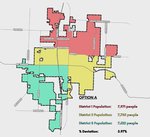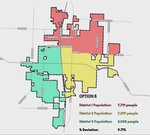


Nixa will have new city council districts ahead of the municipal election on April 5, 2022.
The Census just released what is referred to as the "redistricting product." That sent Nixa Director of Planning and Development Garrett Tyson into action examining the population and how it falls on the map.
The Nixa Home Rule Charter requires that Nixa be divided into three districts, and that each district have equal population with the other two districts, but that districts must be geographically compact and contiguous.
"This is required that we do this following every decennial census, required by our charter" Tyson said, meaning any U.S. Census that occurs every 10 years.
The charter also calls for the redistricting process to be complete in time for the next municipal election. Tyson explained that the Nixa City Council has a deadline of Dec. 7, 2021, because that is when filing would open for anyone wishing to run for the Nixa City Council in April 2022.
The districts may also be drawn in such a way that they are consistent with the voting precincts that the Christian County Clerk is responsible for drawing up and enforcing. Like the city of Nixa, Christian County is also suffering from delays in accessing data from the U.S. Census. Tyson said he had a lengthy meeting with Christian County Clerk Kay Brown, and that the clerk will not redraw voting precincts for Christian County until after Nixa has already drawn its new city council districts.
Nixa, according to the census, has a population of 23,278. Divided by three, that makes for three districts of roughly 7,759 people each.
Nixa City Council District 1, the northernmost district, is the most populated, according to the 2020 U.S. Census. It has 10,087 people, or about 2,328 people above the ideal population as it relates to District 2 to the south and east, and District 3 to the southwest. Overall, the idea is to make the geographic boundaries of District 1 smaller, and make Districts 2 and 3 larger in both population and in area.
The number of registered voters in each district does not matter, under state and local laws.
"It is people, just people, not voters, not adults, just people," Tyson said.
While it isn't part of the legal criteria, Tyson said it's a good practice for planners to use major streets or natural boundaries as much as possible when drawing up voting districts, because it helps reduce confusion for voters whose district might change during the redistricting process. It's also a good practice for making voting friendlier to people who move into a growing community, like Nixa, to know which of the three districts they live in.
"Part of the issue is communicating to people about where their district is compared to where they live," Tyson said. "It's always more helpful if you can say, 'Hey, if you live south of Highway 14 and east of 160, you're in this district as much as possible, we try to use major landmark roads, major arterials as the dividing line to accomplish this."
A city council committee consisting of District 1 Councilwoman Amy Hoogstraedt, District 2 Councilman Shawn Lucas and District 3 Councilwoman Darlene Graham will study the options, make any changes or directions to city staff members, and return a more finalized district map to the entire six-member city council. On Sept. 9, Tyson presented two preliminary options with mapped illustrations.
"There are pros and cons, I think, to both of these," Tyson said. "I showed both of these to the county clerk, asked for their feedback, they didn't see any red flags or anything we can't work with from a precinct level."
Tyson felt that what is called "Option B" is probably easier from a geographic standpoint, as far as explaining the new districts to voters would go. However, "Option A" offers a closer mathematical balance when it comes to the voter populations of the three districts.